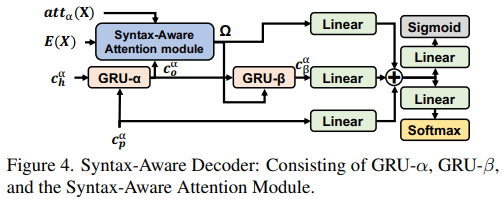Syntax-Aware Network for Handwritten Mathematical Expression Recognition
A Tree-Structured Decoder for Image-to-Markup Generation(https://www.zhuanzhi.ai/document/f09d28ca52b77a13a13bf44a86aba64d)
Handwritten Mathematical Expression Recognition via Attention Aggregation based Bi-directional Mutual Learning
思路概览
和A Tree-Structured Decoder for Image-to-Markup Generation思路一致,看起来是为了数学公式增加了一些细致的规则。

SAN的工作本质原文描述如下:
The SAN transforms an image into a parse tree, of which the leaf nodes are terminal symbols or relations, and others are non-terminal symbols. There are two non-terminal symbols S and E, where S is the start symbol and servers as the tree’s root.
作者将SAN分成七个组件,G = (N, Σ, R, S, Γ, C, D):
- a finite set of nonterminal symbols (N),
- 实际latex符号 a finite set of terminal symbols (Σ, non-terminal symbols), contains all symbols that might be used in a LaTeX expression sequence.
- 建树规则 a finite set of production rules (R), production rule can be used to construct the parse tree.
- 子树起始符,这个应该属于N a start symbol (S, non-terminal symbols), is the start symbol and servers as the tree’s root.
- 关系符号 a finite set of relations (Γ),
- an encoder (C)
- a decoder (D).
父节点类型N(非终端节点)根据生成规则R可以生成一系列终端Σ、非终端N、关系Γ子节点。
建树规则
非终端符号S产生:
1) an arbitrary terminal symbol followed by an S on the right
2) an E
3) an empty string

非终端符号E对Γ中的每种关系产生一个子树,并将这些子树concat起来

看到这里就大概明白了作者的意图,起始S符号,然后:
- 输出σS,表示当前位置为符号σ,下一个S输出修饰σ的子树
- 输出E,表示修饰S兄弟符号σ,递归预测
- 输出空,表示S的兄弟符号无需修饰
对于某个字符的关联字符(E位置),节点子树为修饰用,对各种可能的关系进行探索,各个关系平级(结果之间concat)。
下图是生成树的规则示意:

节点推理该率分布表达如下(父节点到子节点,X为图):

相邻符号有九种可能关系:left, right, above, below, low left, low right, upper left, upper right(?)
Latex语法树生成的两个原则:
- It follows the standard reading orders: left-to-right, top-to-down.
- The spatial relations between adjacent symbols are used. 相邻符号之间存在关系符号
解码过程







【推荐】国内首个AI IDE,深度理解中文开发场景,立即下载体验Trae
【推荐】编程新体验,更懂你的AI,立即体验豆包MarsCode编程助手
【推荐】抖音旗下AI助手豆包,你的智能百科全书,全免费不限次数
【推荐】轻量又高性能的 SSH 工具 IShell:AI 加持,快人一步
· 10年+ .NET Coder 心语 ── 封装的思维:从隐藏、稳定开始理解其本质意义
· 地球OL攻略 —— 某应届生求职总结
· 提示词工程——AI应用必不可少的技术
· Open-Sora 2.0 重磅开源!
· 字符编码:从基础到乱码解决
2018-07-17 『TensorFlow』SSD源码学习_其三:锚框生成